Getting into Sushi Masaki Saito is probably the most
frustrating part of the experience. Opened five days a week, the restaurant
does two seatings nightly – up to five diners starting at 6pm and up to seven
people at 8:30pm. Despite the odd number availability, trying to book for a table
of three is impossible, and I had to eventually give up.
So, how did I get my reservation? It took weeks of signing
onto Tock on Tuesdays at exactly 11am and searching a table for three
(fail) and then quickly switching to a table for two (ding ding ding) before
finally securing a reservation after several attempts. Reservations open one
month in advance and the Tuesday time frame was when the Friday seatings were
released. Good luck and may your patience be with you.
Arriving in front of 88 Avenue Road, a flight of stairs led
us to their doorway past a set of navy drapes. As soon as I pushed through the cloth,
smiling faces greeted me, beckoning me to come up to the warmth of the dining
room. Before we were seated, they led us into a sitting area where we could peruse
their sake menu while the chefs finished setting up and we waited for the other
guests to arrive.

At $680 per person, dining at Masaki Saito is a special
occasion affair where you’re paying a premium for these elements:
- Their fish is flown in from Japan twice a week on a direct
flight for maximum freshness. It’s interesting a direct flight is required
given so much of their ingredients are aged before consumption. Presumably,
having the fish aged in kelp or hung is very different than sitting packed in
ice.
- Rice, being the cornerstone of sushi, is equally if not more
important. Saito buys award winning rice from the Nikka prefecture from a
supplier that exclusively sells to them in Canada. You can taste the difference:
the rice is sticky but also fluffy so that you can feel each grain as you bite
through it. Mixed with a blend of five
red vinegars, the rice takes on a brown hue that’s unlike other sushi I’ve
sampled.
- Condiments are also made in-house, their ginger takes a week
to develop and uses bamboo ginger so that it’s really crisp, fresh, and not
overly pungent. Even the wasabi is enhanced by having the chef chop to the
group wasabi root to make a really smooth paste.
- You’re paying for the décor, including the sushi counter
made from 200-year old Hinoki wood imported from Japan. Sadly, their roof
collapsed during COVID, so parts of the bar are damaged, but it still has a lovely,
reclaimed wood look. Their wood cabinetry was also made by craftsmen in Japan
to make you feel like you’re dining in Edo.
- Rest assured, despite being over a 2-hour dinner, you’ll be
comfortable on the oversized plush bar stools. The design of the sushi bar is
well thought out with an under-counter shelf to store purses and a raised
marble ledge that acts as a footrest. You don’t even need to reach for the
dishes as Chef Saito places them down, a server quickly whisks it from the bar
and transfers it in front of you.
- Ultimately, you’re paying for Masaki Saito who is there the
whole time, preparing and serving the courses. No step is below him from
grinding the wasabi to mixing the vinegar into the sushi rice (a technique
that’s taken him ten years to perfect).
Seven appetizers began the meal before the first nigiri made
an appearance. Octopus was slowly simmered allowing the outer layer of the
tentacle to become gelatinous, almost like pork belly, while the centre remained
meaty and tender. Simmered in a roasted green tea, it’s already flavourful but
with a dollop of spicy yuzu it morphed into a vibrant bite. With two pieces,
I’d recommend having one solo and another with the spice.

The potential gumminess of the raw Botan ebi was minimized
by marinating the sweet shrimp in a fermented rice sauce allowing the seafood
to soak in flavours and mellow. At Masaki Saito, there’s certainly no shortage
of uni, the first topped the shrimp and created a chewy creamy bite with
a refreshing finish from the citrusy sisho flowers.
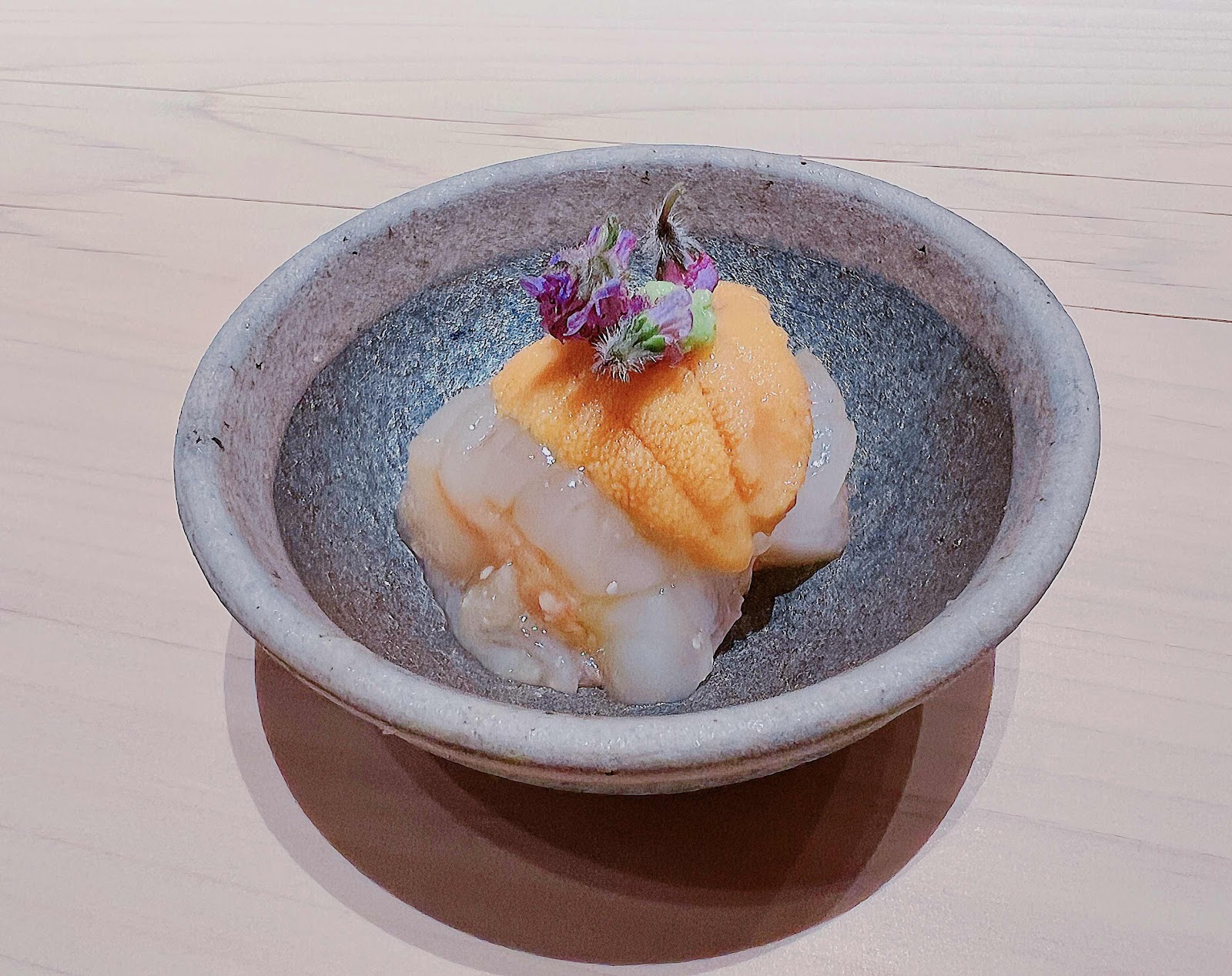
Even though Chef Saito removed the skin off the saba and
the mackerel was seared and paired with grated daikon, I still found it tasted
fishier than I’d like. Hello taste buds! Let me grab a sip of sake to chase
that away.

Another fantastic uni combo followed paired with deep-fried
tile fish and its scales. The meatiness of the fish, crunchiness of the scales,
and silkiness of the sea urchin was an amazing combination and one of my
favourite bites of the evening. We’re told to eat it in one bite… do yourself a
favour and give it a minute to cool down as it’s incredibly hot and I would
have scorched my tongue if it weren’t for the cold relief of the uni.
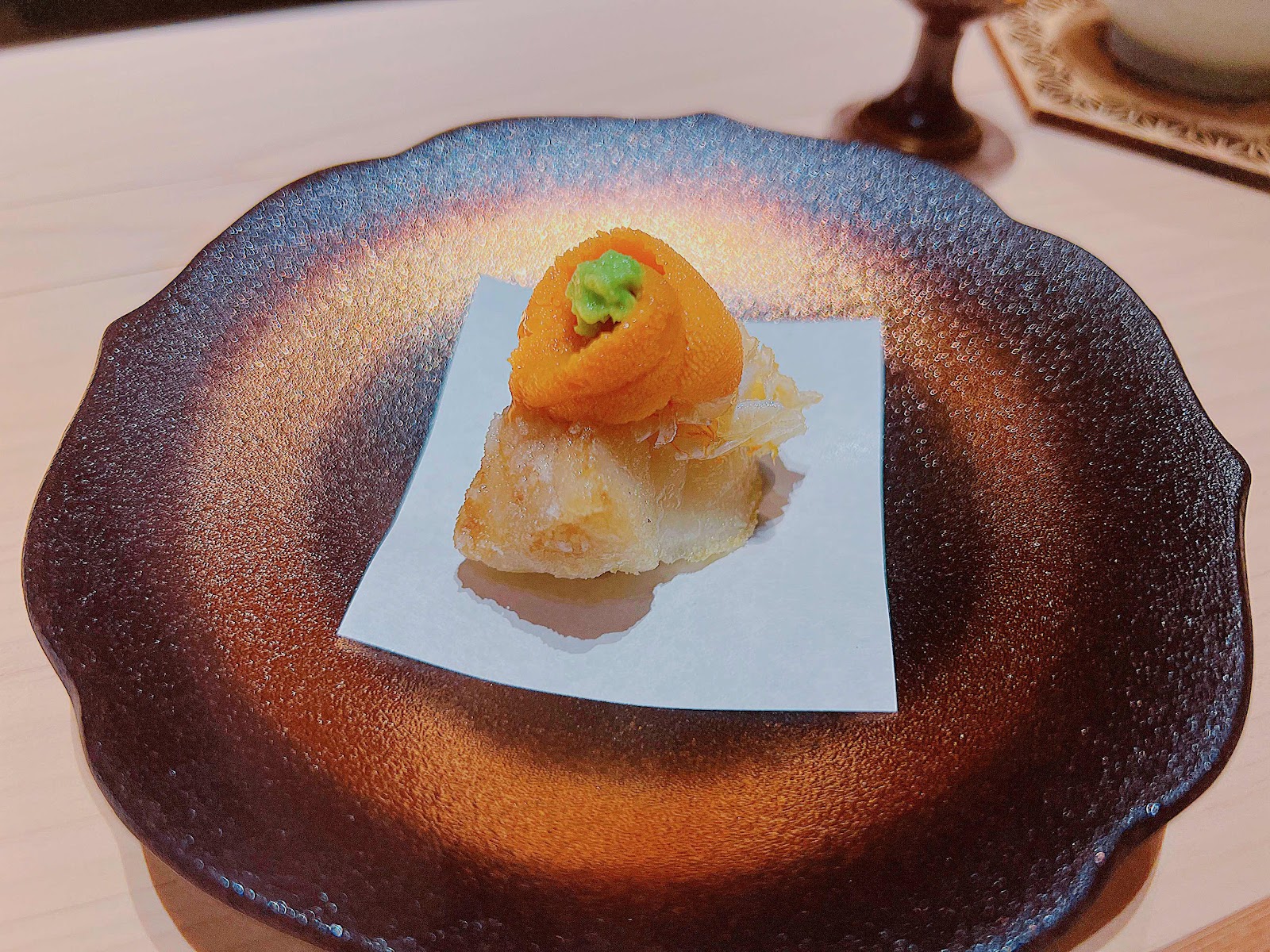
Chef Saito derives inspiration from various Japanese cuisine
including shabu shabu, which inspired the luscious sesame sauce he coats
slices of wild yellowtail into so that the delicate fish was swathed in a
fragrant paste made from three types of sesame, soy, and chili oil.

Soaked in the rich sesame, the yellowtail has a tuna-like
finish, and the starter feels like eating salad with the fish topped with fine
slivers of ginger, green onion and sisho leaf. Be sure to smell the dish
before eating. It’s so aromatic and consequently also why the restaurant
recommends not wearing strong perfumes to dinner.
Cue the dreaded shirako, a blubbery fish sperm sack I’ve
tried in Japan that’s haunted me. They jokingly describe it as a roasted marshmallow…
good luck convincing a kid to put this into a smore! Roasted over glowing hot Japanese
oak, the milt roe is simply topped with cool caviar.

The shirako is soft and creamy, akin to a silken tofu,
and thankfully didn’t have the gross bitter fishiness I experienced in Japan. While
this still isn’t my favourite piece, it was nonetheless a good bite and I loved
that it brought out Chef Saito’s cheekiness as he described his thought process
of pairing the sperm with eggs.
And the last appetizer was a bowl of pickled Japanese
cabbage with orange zest, a nice palette cleanser between the shirako and
sushi.
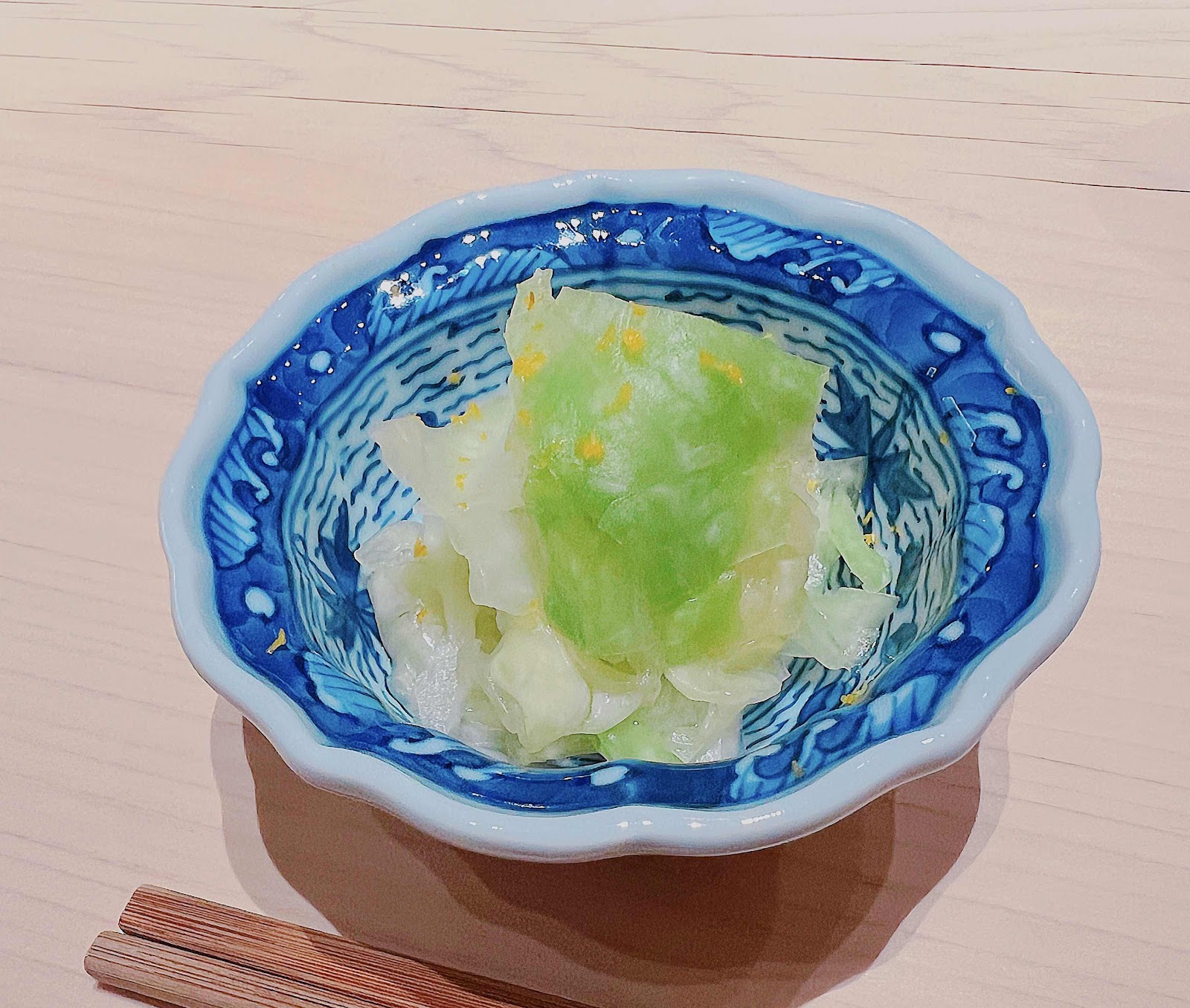
We’re advised that Chef Saito prefers to serve his sushi
hand-to-hand so that the rice remains at the optimal body temperature and diners
can put it directly into their mouth with the fish side down. Consequently,
this is why I’m missing some sushi photos and the ones that are shown aren’t
the greatest quality … I indulged hand-to-hand prior to sneaking a photo of my
neighbour’s bite.
A golden eye snapper that’s aged for a scant four days
(compared to some of the other seafood that follows) begins the sushi
procession. Having been aged in kelp, the seaweed gives the fish another level
of umami creating a lovely taste that lingered on the tongue.

After the first piece, we’re advised that Chef Saito can
customize the bites to our tastes, whether we want more or less rice or wasabi.
Indeed, this level of precision is certainly a factor that likely helped Sushi
Masaki Saito earn a second star.
Another dish that was a miss for me was the ark shell clam. Perhaps
it was because I was already traumatized after a staff member told me it was
alive as the chef scored it - realizing a living creature was suffering was
certainly something I didn’t need to hear. It also doesn’t look the greatest
spread out on the cutting board… it looks awfully like it could be part of a
women’s anatomy. Ultimately, it just didn’t taste good: the clam needed a
stronger glaze or condiment to cover the gaminess of the seafood. In the end,
if the clam was dropped from the menu, it wouldn’t be missed.

Chef Saito then takes the skirt of the ark shell clam and
creates a maki wrapping it with spices and sisho leaf. Having
been marinated and well rinsed, the gaminess of the clam was subdued. Still, the
crunchy texture of the mollusk is still an acquired taste.

Luckily, it was followed by a stronger hay-seared Spanish
mackerel, which had a lovely meaty smokiness. Unlike the prior mackerel, this
was not fishy, despite only being garnished with a rich soy sauce.
As soon the blubbery bits of fish liver were presented, I
knew we were in for a treat. Chef Saito sandwiched the liver between a slice a
file fish and rice to create an incredible texture combination: as you bite
through the fish’s soft flesh, you’re greeted with the silky liver filling.
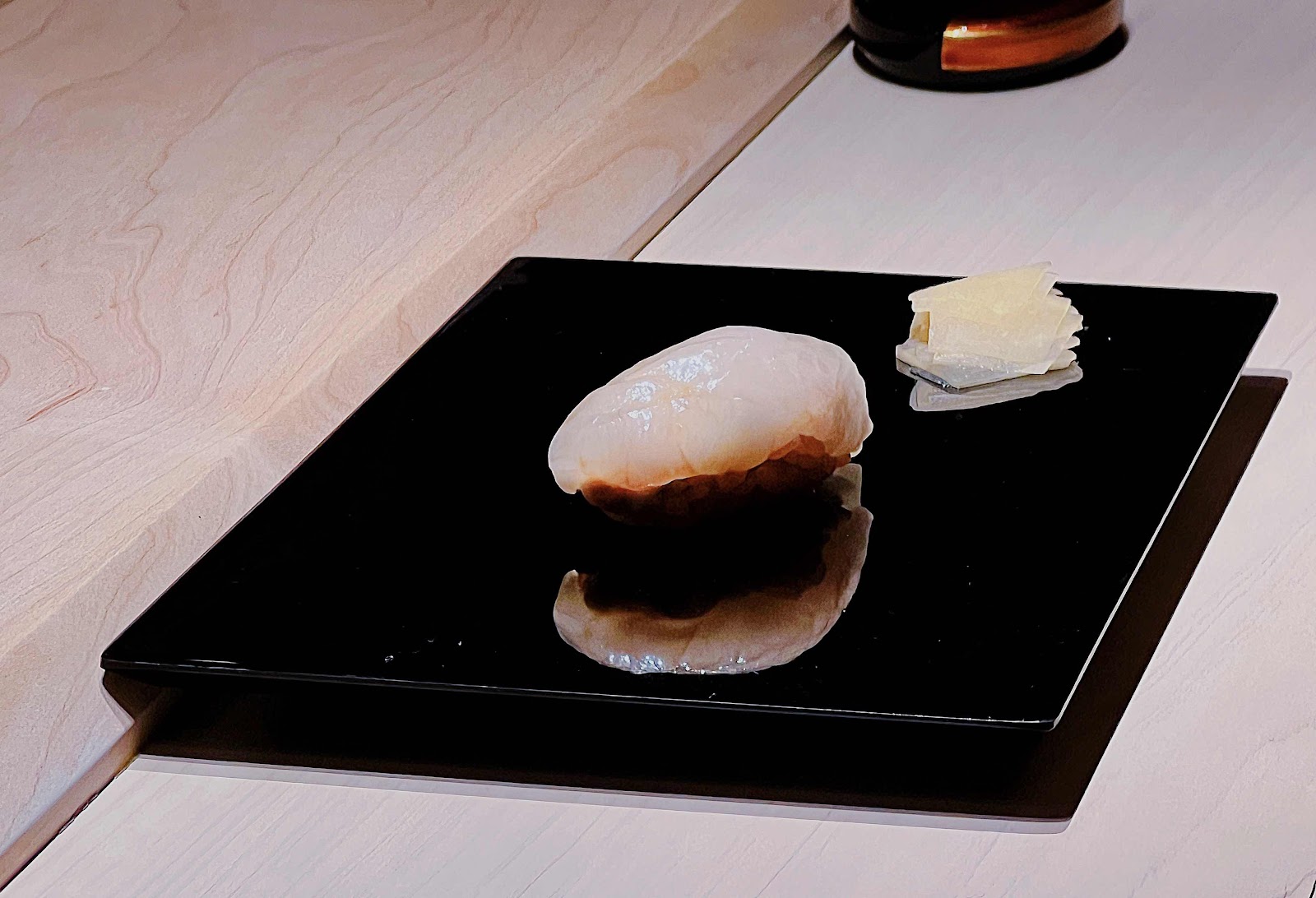
We’re told not many chefs create this sushi as it takes
skill to ensure it all holds together. I love how they are using different
parts of the fish, perhaps topping this with a couple of crunchy fish scales
would make for an even more fulsome presentation.
Next, a seven-day dry aged toro was served and the blue
fin tuna was of course an explosion of flavour. At Saito, theirs was less
greasy and the flavour lingered longer on the tongue.

If you like stir-fried ginger and onion lobster, the
following needle fish has a flavour reminiscent of the dish thanks to the
finely chopped scallion paste topping the fish and the ginger paste inside. It’s
a bit surprising these stronger flavours were used on the needle fish, which
seems like a more neutral fish. While delicious, this should have been paired
with the ark shell clam to mask its gaminess better.
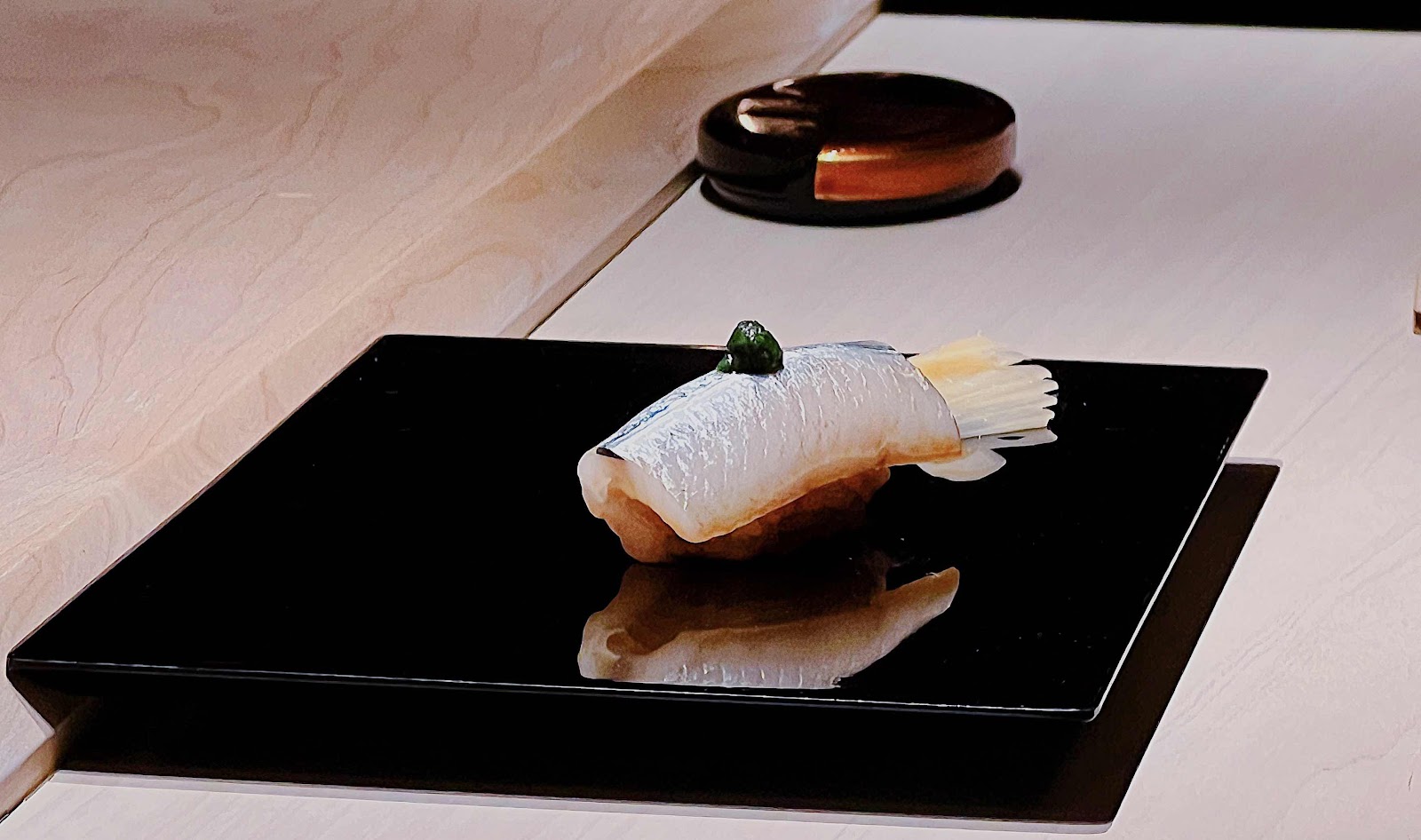
The meaty piece of lightly grilled sea perch would be great
on its own. But then, it’s hardly luxurious. Chef Saito amped up the luxe
factor by serving the fish on top of whipped uni sushi rice - the
combination of sea urchin, spices, and rice created a decadent over-the-top risotto.
Dried four-year old fish eggs topped the perch creating a plethora of flavours
and textures that made me wish I could sample each separately. It should be
eaten all together, the chef says, so I listened and devoured it in two
incredible bites.

A pale fish that looked like needle fish followed, except it
was actually slow poached sea eel. Chef Saito slathered a thick molasses-like
sauce on top and added hint of spice with Sandro pepper. The unagi was
unlike others I’ve had; it melted into the rice and tongue flooding my mouth
with a sweet umami essence.

On the left of the sushi bar, you’ll notice a trio of brand
name chests on display. Chef Saito pulled out the LV one and joked it’s his
tuna chest (the others house caviar and truffle as well as a rare whisky).
Within the tuna chest, we were treated to a toro and pickled daikon paste.
Nori was toasted piece-by-piece and presented to Chef Saito who quickly
added rice, spices, and the tuna paste before handed it to me, so the seaweed
was still hot and crispy. Yum!
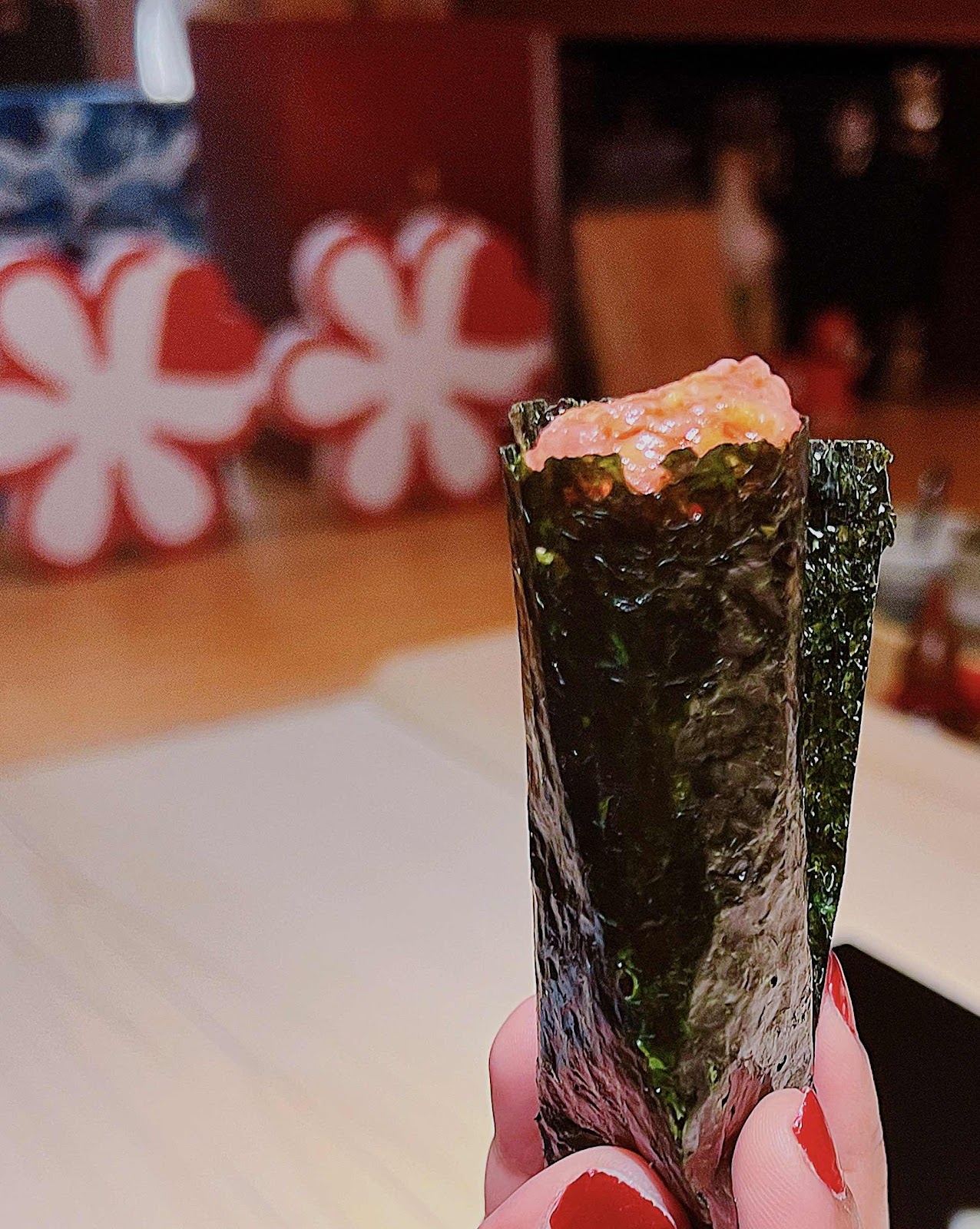
As the tomago arrived, I got ready for the meal to
end. And while we had sampled so much, like all great meals, I was still
yearning for more. Saito’s egg cake was mixed with Japanese mountain potato and
sweet shrimp so while there was a sweetness to the tomago, it also had a
rich savouriness.
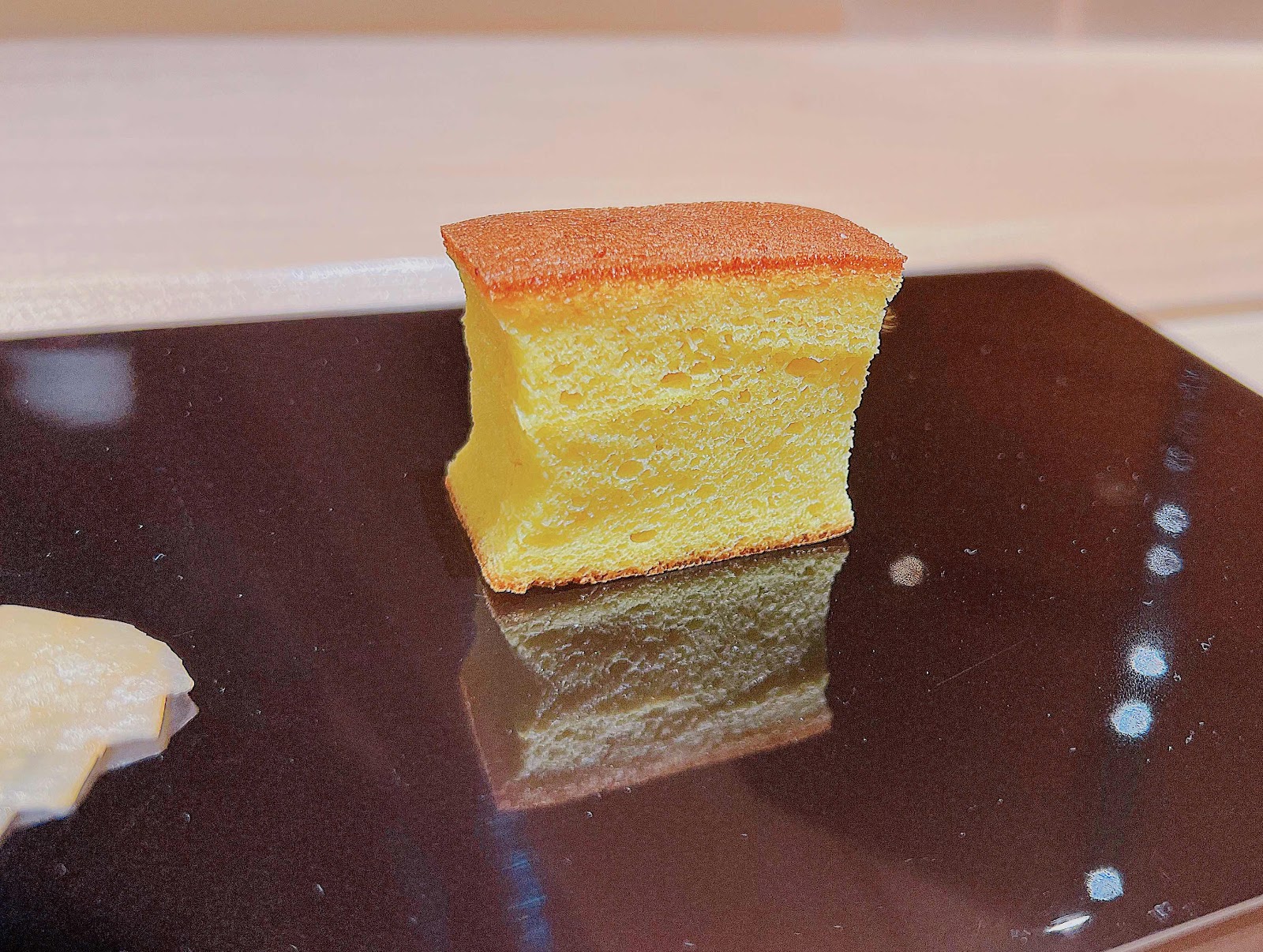
After the sushi, Chef Saito thanked us and left to clean up
before the second seating. There’s a bit of confusion as we thought it was time
to settle the bill. No, not quite yet. A bowl of miso soup arrives, made with different
types of miso and a broth developed with several fish.
Of course, Saito doesn’t simply boil the broth the day of,
it was cooked over seven days to concentrate the flavours. In the end, the miso
soup was rich but not overly salty and while I did need to stir the miso into
the broth, it also didn’t separate much either. As a finish, pieces of finely
chopped seaweed and scallions were added to make the soup more substantial.
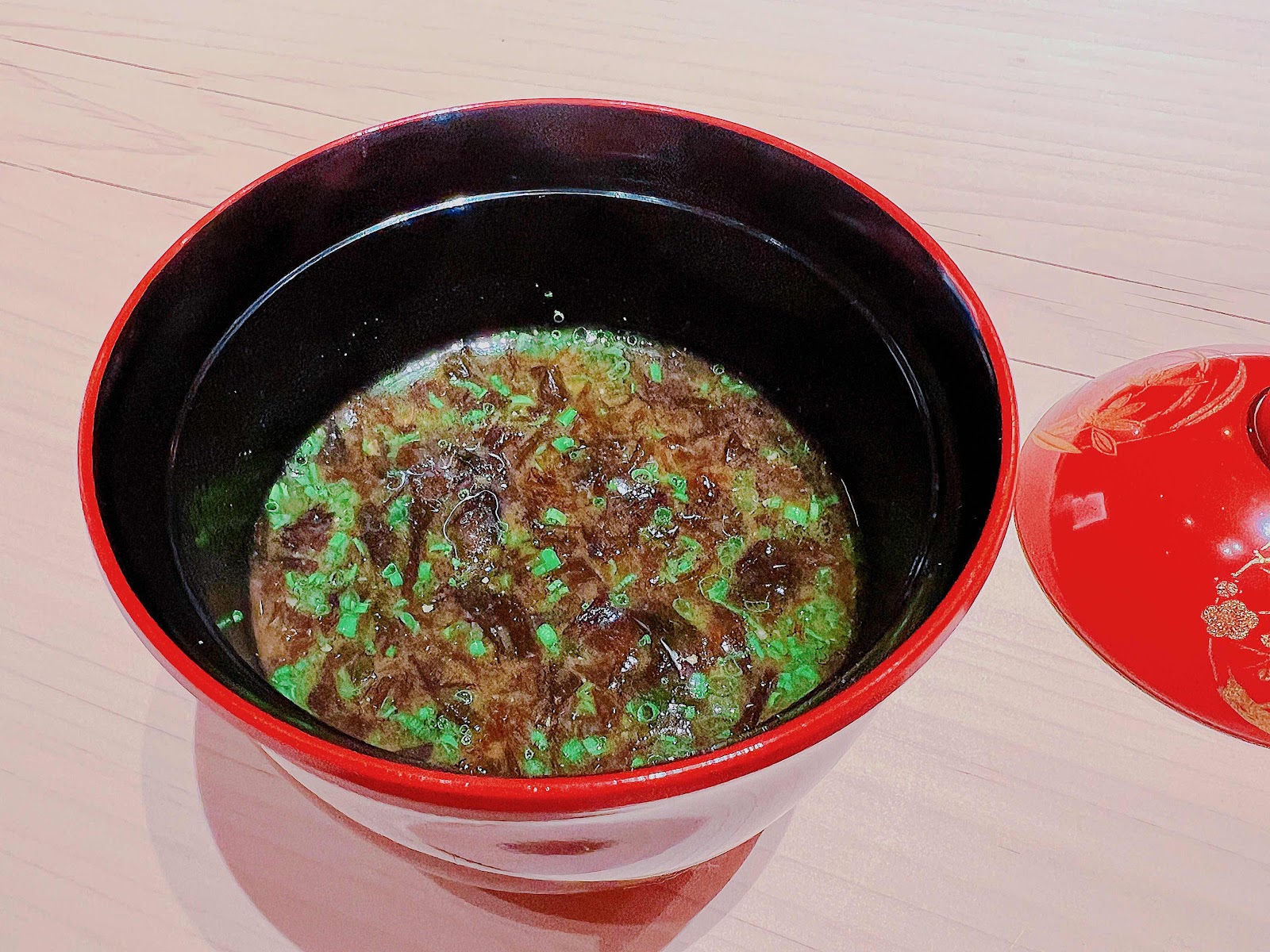
Surprisingly, dessert was not a slice of musk melon - this
is reserved for birthdays and anniversaries - but rather an actual sweet treat.
The matcha blancmange consisted of a silky coconut milk base, topped
with smooth thickened matcha and a single red bean that’s oh so creamy. A
heavenly way to end the meal.

The meal was exquisite and being in such close proximity to
Chef Saito we were able to converse with him. He’s certainly happy with the
Michelin recognition but is quick to point out the earning the accolade was a
group effort. Still, he will not rest of his laurels and knows he will continue
to develop and improve his craft. The life of a true chef.

Note to diners: Tipping isn’t the easiest affair as the pay
terminal doesn’t have a % calculation option and you need to add back the
prepaid portion when doing your own calculation. Hopefully, Sushi Masaki Saito
will eventually just charge the entire meal experience up front on Tock with
taxes and gratuities (a practice many other restaurants follow). That way,
guests only need to settle the drinks on the day of, making it an easier calculation
for all.
Overall mark - 8 out of 10
How To Find Them
Location: Toronto, Canada
Address: 88 Avenue Road
Follow me on twitter to chat, be notified about new posts and more - https://twitter.com/GastroWorldBlog
____________________________
Gastro World's Grading System
- Anything under 5 - I really disliked and will never go back
- 6 - decent restaurant but I likely won't return
- 7 - decent restaurant and I will likely return
- 8 - great restaurant that I'd be happy to recommend
- 9 - fantastic restaurant that I would love to visit regularly and highly recommend
- 10 - absolute perfection!
Is That It? I Want More!
Other Gastro World posts similar to this:




